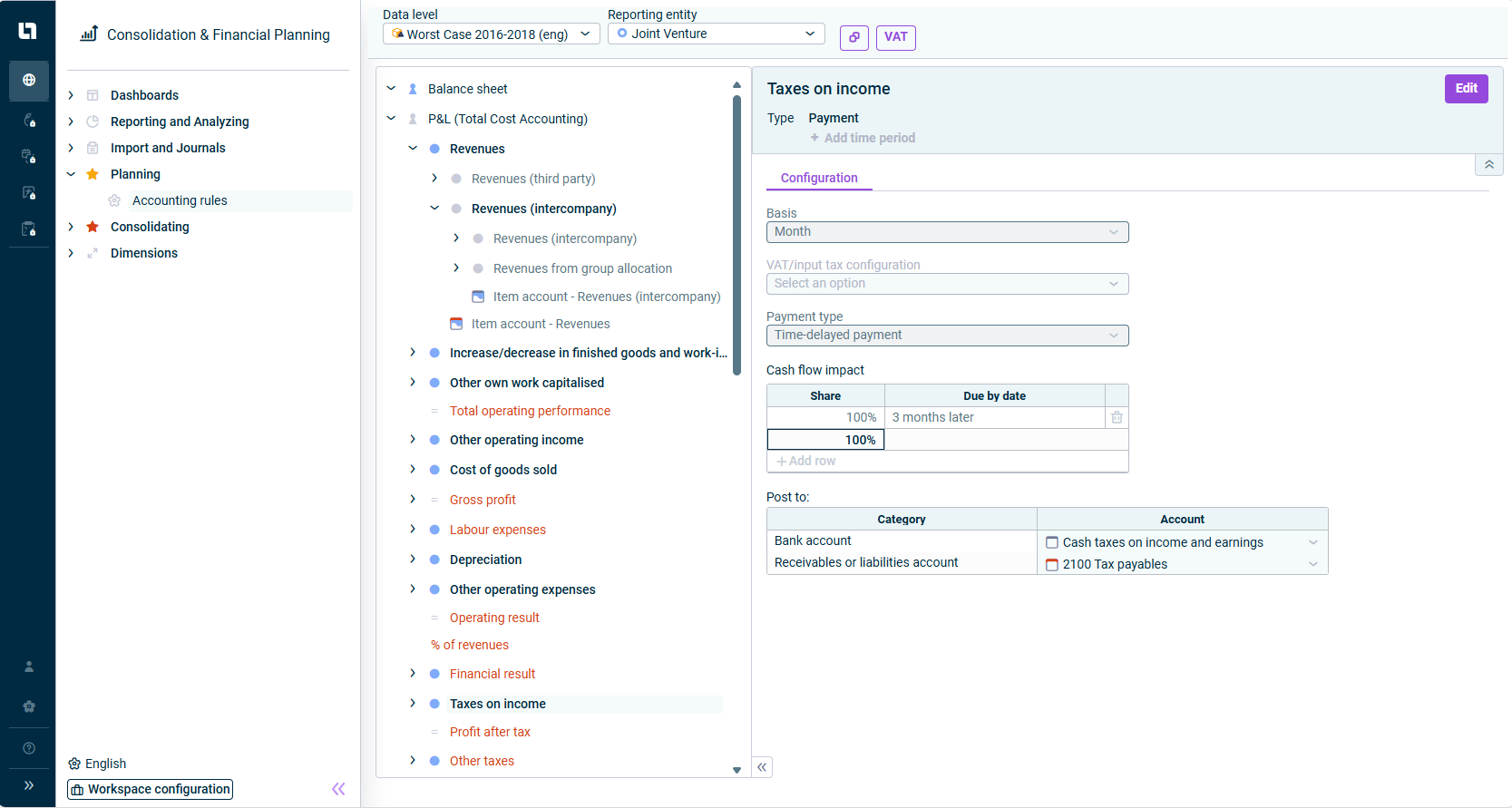Accounting Rules
Last updated on 2025-07-02
Overview
The Accounting rules workspace is used for configuring rules for automatic contra entries. For each combination of data level and reporting entity, a journal exists in this workspace which contains all of the accounting rules for the respective combination pair.
In Lucanet, one-sided postings (only one account is addressed on the credit or debit side) can be made by means of Sheets or Excel using the keyword auto posting. However, since postings in Lucanet can only be saved if the credit side matches the debit side, an automatic contra entry must be made at the same time in case of a one-sided posting. This entry is made by the system using accounting rules that were defined for the corresponding accounts in the Accounting rules workspace. The system uses automatic contra entries in the following cases:
- Data imports of import type Automatic posting
- Excel postings using the keyword Auto posting
- Sheets (except Balance sheet adjustment)
- Posting with access to the account hierarchy name of the general ledger incl. subledgers (automatic posting)
Automatic contra entries can be used to plan only one profit and loss statement from which a planning balance sheet and a planning cash flow statement are automatically created by the system based on defined accounting rules.
This article contains the following sections:
Navigation
The Accounting rules workspace can be found in the Overview under the Planning folder and is displayed as follows:
Formatting general ledger, subledgers, accounts and items
The following formatting options are available:
Formatting
Description
red
Applies only to accounts, items or folders and it means they are not activated.
red + matt
The configuration of the superordinate item applies (the contra entry of the superordinate item is not activated).
black + bold
An accounting rule is defined for the general ledger, subledger, item or account.
grey
The configuration of the superordinate item applies (the accounting rule of the superordinate item is activated).
The general ledger, subledger(s), and statistical ledger(s) are always black, even if they are not activated.
Accounting Rule Types
The following accounting rule types are available:
Accounting rule type
Description
The Payment accounting rule type is used for all accounts and items relating to business transactions with a cash flow impact. It is the most frequently occurring rule in the P&L.
The accounting rule type Payment is only available for accounts and items with the period type Transaction figure.
The Investment accounting rule type can be used to plan new investments and their depreciation/amortization. The configuration specifies the bank account, value-added tax and cash flow impact. Furthermore, the depreciation/amortization rule including the useful life and the accounts for the accumulated depreciation/amortization are determined on the balance sheet and the expense in the P&L.
The accounting rule type Investment is only available for accounts and items with the period type Balance with carry-forward from previous period.
The Accruals and deferrals accounting rule type is used for entering business transactions for the appropriate period in Lucanet. Using this accounting rule type, for example, it is possible to plan business transactions in which the services are purchased or sold in advance whereas the payment is made as a one-off payment in advance.
If the accruals and deferrals process is repeated at particular intervals and with a specific amount, then the planning can be repeated automatically. This is practical when recurrent business transactions are involved, e.g. insurance premiums that have to be paid annually in advance.
The accounting rule type Accruals and deferrals is only available for accounts and items with the period type Balance with carry forward from previous period.
The Contra entry accounting rule type is used for recording postings within or between P&L and balance sheet. This type of contra entry is used with depreciation in the fixed assets, for example.
Depreciations do not have a cash flow impact, but reduce the value of the fixed assets (accumulated depreciation) in the balance sheet, and thus require a contra entry.
The accounting rule type Contra entry is available for both accounts and items with the period type Balance with carry forward from previous period and Transaction figure.
